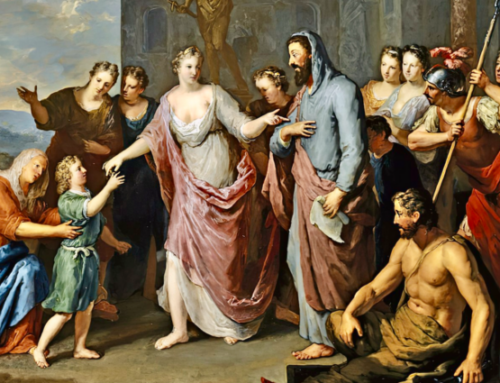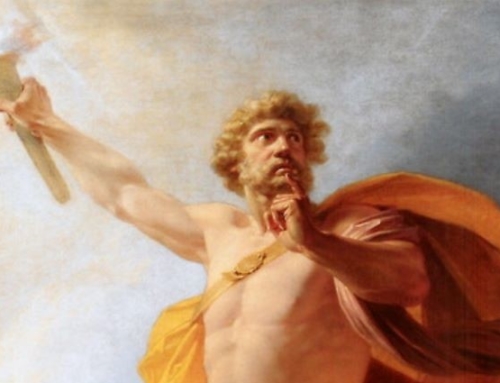Russell Kirk gave voice to a myriad of persons, personalities, and ideas circulating in the decade after the Second World War, just as the West was trying to understand what it stood for, rather than what it stood against. The latter was easy. Communism and fascism were evil. But, what exactly did the West stand for?
 When Russell Kirk (1918-1994) published his magnum opus, The Conservative Mind, in May 1953, the entire landscape of the English-speaking world changed. Though originally a dissertation entitled The Conservatives’ Rout, Kirk’s book gave voice to a myriad of thinkers and thoughts previously uncoalesced but swirling—sometimes anxiously and sometimes violently and, most often, just confusedly—in the powerful desire to be something more than merely anti-communist. Did America, and by extension Anglo- and Western civilization actually stand for something? It is one thing to resist and to criticize, but it is an altogether different thing to promote and to build.
When Russell Kirk (1918-1994) published his magnum opus, The Conservative Mind, in May 1953, the entire landscape of the English-speaking world changed. Though originally a dissertation entitled The Conservatives’ Rout, Kirk’s book gave voice to a myriad of thinkers and thoughts previously uncoalesced but swirling—sometimes anxiously and sometimes violently and, most often, just confusedly—in the powerful desire to be something more than merely anti-communist. Did America, and by extension Anglo- and Western civilization actually stand for something? It is one thing to resist and to criticize, but it is an altogether different thing to promote and to build.
Scrupulously careful to avoid creating yet one more new ideology in a world awash in them, Kirk claimed that true conservativism, while standing for much, represented a non-, anti-, and ante-ideological position. Conservativism, instead, was the “negation of ideology,” being neither left nor right, but pro-humane while ideologies, one and all, were anti-humane. Conservatism, as such, transcended the political divisions and squabblings of the ideologues of the left and the right.
Six Canons of Conservative Thought
Kirk asserted that six main ideas, or “canons,” helped explain conservatism, but they didn’t delimit or define conservatism in any absolute sense. A canon, rather, expressed something dogmatically—a good but little truth. The canons, therefore, could be mixed and matched and, sometimes, even dismissed and ignored. Kirk’s canons proved to be something fundamentally different from, say, Mussolini’s formulation of fascism, or Marx’s six points of Communism, or the twelve-step program to fight addiction. In essence, Kirk’s canons far more represented the canons of, say, the Council of Trent, ready to be formulated as a decree, not necessarily the only truth, but a truth within and around a million other truths. Kirk’s six also reflected the Common Law tradition of the English-speaking world, promoting the universal truths of human dignity while recognizing the culturally and temporally specific circumstances of a particular manifestation of a universal truth. A jury is a perfect example. Everywhere and always, it must have members from the community, but any one composition of a jury is never—under any circumstances—repeated. Thus, there is the universal, and there is the particular.
During his own lifetime, Kirk even attempted to change the number of canons. From time to time, he would espouse the six canons as found in The Conservative Mind. At other times, he listed four, five, and, toward the end of his life, even ten. In the 1953 edition and in all subsequent six and half editions of the book, The Conservative Mind listed these six, though the wording of each changed dramatically between 1953 and 1986 (when the revised seventh and final version appeared). First, that a god or God (or natural law or “divine intent” or Providence) rules over time and space “as well as conscience, forging an eternal chain of right and duty which links great and obscure, living and dead.” As a corollary, one must—as Irving Babbitt did—recognize that no single issue in this world can be separated from all other issues. “Political problems,” Kirk wrote, “are religious and moral problems” and demand an ethic and morality that transcends time, place, and culture. Second, that each person, as Saint John Paul the Great would later put it, is an unrepeatable center of dignity and liberty. Or, as Kirk put it, one must love “the proliferating variety and mystery of traditional life, as distinguished from the narrowing uniformity and equalitarianism and utilitarian aims of most radical systems.” Each person matters, therefore, and God makes nothing in vain.
Third, a recognition—especially taking into account the first two canons—that each human person, in talent and motivation, is radically different from every other human person. We share equality in the sight of God and before the law. Otherwise, though, we should recognize that what makes us human is what makes us individually gifted. One is a teacher, another a counselor, another a cellist, another a dancer. Our excellences fundamentally distinguish us, one from another. As such, Kirk argued, society should be naturally hierarchical rather than artificially equal. To promote only equality is, for all intents and purposes, to slap God in the face and argue with Him that His distinctions confuse rather than leaven.
Fourth, as did the American Founding Fathers, understand that all rights are, in and of themselves, property rights. If we do not possess rights to property, we possess no rights whatsoever. After all, the right to life, the right to liberty, and the right to happiness are merely three different ways of acknowledging that we own ourselves. While property might mean marginal things such as land ownership, it fundamentally means ownership of self—the declaration that we can govern and restrain ourselves within community and society.
Fifth, an inherent (but never blind) trust that the experience of humanity overall is better than the ideas of a specific person or time. Given the body of evidence—as seen by the Church or by Common Law—the conservative understands that emotion guides man and men as often as not and, thus, “tradition and sound prejudice provide checks upon man’s anarchic impulse.” The human person must, Kirk argued, restrain “his will and appetite,” and he must distrust those who claim to have all answers, to understand all things, or who want to create heaven upon earth.
The fourth and fifth points lead immediately to the final and sixth canon, that every generation must judge the inherited goods—spiritually and materially—from the perspective of prudence, the classical virtue of choosing good from evil. When each generation receives the gifts of previous generations, it must reform, abolish, or pass on what has been given. It judges inherited goods by the norms of good and evil. Does the inheritance leaven or crush the dignity of the human person? Most things, Kirk believed, are mingled good with bad. “Change and reform are not identical,” he wrote, “and innovation is a devouring conflagration more often than it is a torch of progress.” Thus, one must judge by the lights that Providence has given each person.
Five (or six) Schools of Thought into One
As noted above, Kirk’s The Conservative Mind gave voice to a myriad of persons, personalities, and ideas circulating in the decade after the Second World War ended and the West, especially in the English-speaking countries, as they were trying to understand what they stood for, rather than what they stood against. The latter was easy. Communism and fascism were evil. But, what exactly did the West stand for? That is, what did it and they advocate? Granted, we despise Hitler and Stalin, but do we love Washington and Lincoln?
Five major schools of thought profoundly influenced Kirk’s six canons, though, of course, it must be noted, Kirk was very much his own man—an anti-individualist individual. The school of thought that most shaped Kirk’s own was that formed by Harvard’s Irving Babbitt and Princeton’s Paul Elmer More, Humanism, during the years prior to and following the First World War. Babbitt and More, along with T.S. Eliot and others, believed that society could only advance by rediscovering the ancient virtues of Buddhism, Hinduism, Aristotelianism, Roman republicanism, and Confucianism. Each of these, according to Babbitt and More, taught that restraint of will mattered more than assertion of will. In his own writings, ideas, and even language employed, Kirk could have easily been the student of Babbitt or More, though he knew their work only through their books and students.
The second school of thought was that of Thomas Jefferson and, more recently, E.L. Godkin and William Graham Sumner, the school remembered as “classically liberal.” Best represented by Friedrich Hayek when Kirk was writing The Conservative Mind, these thinkers had stressed not only the traditional norms of Judeo-Christian civilization, but they had argued that constitutions and bills of right existed to restrain authority and to allow the individual talents of persons to reign.
Kirk’s hero, Albert Jay Nock, one of the finest writers and thinkers of his day, represented the third school, anarchism. While most persons understandably imagine diabolic men throwing bombs when they think of anarchy, there was certainly a respectable anarchist school of thought in the first half of the twentieth-century that feared the concentration of power among state entities. That fascism and communism arose horrified them, but it did not shock them. What they feared, though, was that the United States, especially under Woodrow Wilson and Franklin Roosevelt, would lead America along a similar—if slower and more friendly—path toward totalitarianism. For thinkers such as Nock and his allies, democracy was not the opposite of tyranny, but merely the tyranny of the majority.
The fourth school of thought, agrarianism, throve in the American South as well as in England. In the former, it took the form of a literary movement that included such prominent figures as Allen Tate and Robert Penn Warren. It called for the end of a federal leviathan and a return of power to localities, localities that would, ostensibly, promote the virtues of agricultural labor as the best form of civilization. In England, Hilaire Belloc and G.K. Chesterton led what was called “Distributism,” the idea that a free society encourages the division of property rather than the concentration of property (in the hands of corporations or governments). The Americans as well as the English held rather nostalgic and Jeffersonian views of the land, to be sure. In literature, though, probably J.R.R. Tolkien’s The Shire best represented a free, agrarian republic.
And, the mention of Tolkien naturally leads to the fifth school, the Fabulists. Even during its days associated with pulp fiction, science fiction (or scientifiction, as it was generally known prior to the early 1950s) and fantasy offered creativity never before seen in literature. With it, one could explore communism, fascism, freedom, individualism, sin, and goodness without bounds. Stories could take place here, or billions upon billions of miles away from earth, or billions upon billions of years one direction or the other away from the present. H.G. Wells, R.H. Benson, G.K. Chesterton, Aldous Huxley, C.S. Lewis, Ray Bradbury, and George Orwell had each made science fiction and fantasy not only respectable, but honored.
All of these schools of thought informed Kirk’s own thinking, and his own quirks and individuality helped mix and match various aspects of each school to fit into his own understanding of conservatism. But, there was a sixth thing as well—not quite a school; indeed, well beyond one—that played a critical role in Kirk’s thought: Roman Catholicism. Though Kirk would not join the Roman Catholic Church (receiving baptism and confirmation at the same time) until August 1964, he had been moving toward and flirting with it for decades. Raised in a spiritualist household, the very young Kirk had witnessed seances, spectral visitations, table hoverings, and all manner of the occult. By the time he reached college, though, he had become extremely skeptical of anything even resembling religion. Gradually, though, through his devout readings of Plato and the Stoics during his military adventures in the Second World War, Kirk had come to believe in Providence. That in 1942. In 1953 and 1954, he met with a prominent Detroit Jesuit, receiving instruction in the Roman Catholic faith. Not until 1964, as just noted, when he married a Roman Catholic, did Kirk fully embrace Catholicism. At that point, he took the name “Augustine” after his patron saint and became Russell Amos Augustine Kirk.
This essay first appeared here in October 2019.
Republished from Logos: A Journal of Catholic Thought and Culture (Fall 2019) with gracious permission from the author.
The Imaginative Conservative applies the principle of appreciation to the discussion of culture and politics—we approach dialogue with magnanimity rather than with mere civility. Will you help us remain a refreshing oasis in the increasingly contentious arena of modern discourse? Please consider donating now.
The featured image is “Saint George and the Dragon” (c. 1470) by Paolo Uccello (1397-1475), courtesy of Wikimedia Commons.







In modern America juries vary in size from six to 23 members.
Thank you.